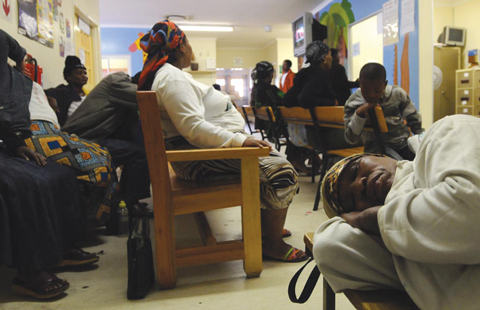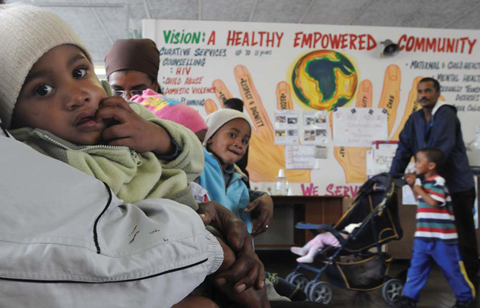a theory of political economic practices that proposes that human well-being can best be advanced by liberating individual entrepreneurial freedoms and skills within an institutional framework characterized by strong private property rights, free markets and free trade . . . State interventions in markets . . . must be kept to a bare minimum.1
the proportion of people living in poverty in South Africa has not changed significantly between 1996 and 2001 . . . [but] those households living in poverty have sunk deeper into poverty and the gap between rich and poor has widened.2
According to Statistics South Africa, in 2001 “the 10% of the population in the lowest income decile shared R1.1 billion, whereas the 10% of the population in the highest income decile shared R381 billion”.3 The Gini coefficient, the most commonly used indicator of inequality (the closer to 1, the greater the inequality) is 0.73 for South Africa, which makes it one of the most unequal societies in the world. Average real incomes actually fell from 1995 to 2000.3
The coexistence of a new political system (controlled by an African elite) and the old economic system (still controlled by a neo-liberal white elite) constitutes a dual system of democratic capitalism which is morally unjust, dysfunctional, and also unsustainable. We are forced to ask: for how long can white wealth and elitism remain entrenched; for how long can the black elite continue to indulge in black elitism; and how far can the black bourgeoisie and the black lumpenproletariat [the lowest members of society or the underclass] extend before the system cracks?4
A similar concern is expressed by Gumede in his account of the rise of Mbeki and the “soul of the ANC”.5
Neoliberalism creates problems not only for the health of South Africans but also for the health of the peoples of many other low- and middle-income countries. The selfish individualism that neoliberalism engenders — described as “the malaise of modernity” by the Canadian philosopher Charles Taylor6 — increases inequality within countries, and spills over into global power relations between rich and poor countries.
Migration from Africa to high-income countries . . . worsens an already intolerable gulf. Its distributive effects may be measured by the perverse subsidy generated . . . Migrant African health care professionals were trained in sub-Saharan Africa at public and private expense; the benefits of that training are then experienced in the UK [and other rich countries such as Australia] and lost to those dependent on African health services.7

Poor countries are subsidising industrialised countries by about US$500 million a year through the migration of health care workers. In South Africa, the outflow of doctors between 1989 and 1997 represents a loss of training investments of US$5 billion.8 More specifically, it has been estimated that in Australia in 2000 there were nearly 1000 South African doctors and over 1100 South African nurses.9 These numbers will have almost certainly increased since then.
Further evidence of the disregard that most rich nations have for the plight of developing nations is their failure to meet the United Nations target of 0.7% of gross national product (GNP) for aid to the developing world. Australia plans to spend only 0.32% of its GNP on foreign aid in 2008–09.10
South Africa suffers from a triple burden of ill health — infectious diseases, non-communicable diseases, and injury and violence (Box). Despite the denialism among some political leaders, HIV/AIDS is the main cause of premature death, accounting for 39% of years of life lost. Other infectious diseases and diseases of poverty, such as tuberculosis, diarrhoea and malnutrition, also impose a major burden.
In 2005, it was estimated that more than 5.5 million South Africans were infected with HIV. Nearly 19% of adults between 15 and 49 years are infected, with prevalence rates of up to 40% among women aged 25–29 years.12 An associated burden of illness is that of tuberculosis, with the emergence of extremely drug-resistant tuberculosis (XDR-TB) exacerbating this burden. The magnitude of the problem of AIDS and TB was made all the worse by the refusal of the South African Government to introduce antiretroviral treatment (ART) until the early 2000s.
Currently, all those with a CD4 count below 200 are eligible for ART.12 Although it will take some time to achieve universal cover, South Africa now has more people taking ART than any other country. The financial cost of addressing this epidemic is potentially enormous — if the government health budget continues at its current level, 47% of it would be required to provide first- and second-line ART for all eligible South Africans by 2014.13 The cost in terms of human life of not addressing the epidemic is even greater.
Given the massive health challenges facing South Africa, and the limited capacity of the health system to meet these challenges, what are the options for change? Mandatory health insurance has been discussed since the late 1980s, but has never been implemented. This is set to change, with the ANC Policy Conference in December 2007 making a very explicit policy commitment to the “implementation of the National Health Insurance System by further strengthening the public health care system and ensuring adequate provision of funding”.14 The precise nature of the proposed National Health Insurance is still the subject of discussion.
For over two decades, annual increases in voluntary private health insurance contributions (medical scheme contributions) have far outstripped inflation rates. Public sector expenditure on health has barely kept pace with inflation or population growth. As a result, the ratio of private spending per medical scheme member to public spending per person dependent on the public sector has increased from 3.6 in 1996 to 5.8 in 2006.15 A mandatory health insurance system would seek to redress these imbalances.

- Gavin H Mooney1
- Diane E McIntyre2
- 1 Curtin University, Perth, WA.
- 2 University of Cape Town, Cape Town, South Africa.
None identified.
- 1. Harvey D. A brief history of neoliberalism. Oxford: Oxford University Press, 2005: 2.
- 2. Schwabe C. Fact sheet: poverty in South Africa. Pretoria: GIS Centre, Human Sciences Research Council, 2004. http://www.sarpn.org.za/documents/d0000990/ (accessed Sep 2008).
- 3. Statistics South Africa. Income and expenditure of households 2005/2006: analysis of results. Report No. 01-00-01. Pretoria: Statistics South Africa, 2008. http://www.sarpn.org.za/documents/d0003023/Income_expenditure_StatsSA_2005-06.pdf (accessed Sep 2008).
- 4. Terreblanche S. A history of inequality in South Africa 1652-2002. Pietermaritzburg: University of KwaZulu-Natal Press, 2002: 138.
- 5. Gumede WM. Thabo Mbeki and the battle for the soul of the ANC. Cape Town: Zebra Press, 2007.
- 6. Taylor C. The malaise of modernity. Toronto: Anansi, 1991.
- 7. Mackintosh M. International migration and extreme health inequality: robust arguments and institutions for international redistribution in health care. In: McIntyre D, Mooney G, editors. The economics of health equity. Cambridge: Cambridge University Press, 2007: 159.
- 8. Padarath A, Chamberlain C, McCoy D, et al. Health personnel in Southern Africa: confronting maldistribution and brain drain. Regional Network for Equity in Health in Southern Africa (EQUINET), Health Systems Trust (South Africa), and MEDACT (UK). Equinet Discussion Paper No. 4. http://www.hst.org.za/uploads/files/hrh_review.pdf (accessed Nov 2008).
- 9. Clemens M, Pettersson G. New data on African health professionals abroad. Working Paper 95. Centre for Global Development, 2006. http://www.cgdev.org/content/publications/detail/9267 (accessed Sep 2008).
- 10. Australian Government AusAID. About Australia’s aid program. http://www.ausaid.gov.au/makediff/default.cfm (accessed Oct 2008).
- 11. Bradshaw D, Nannan N, Laubscher R, et al. South African National Burden of Disease Study 2000. Estimates of provincial mortality: Summary report, Mar 2006. Cape Town: Medical Research Council of South Aftrica. http://www.mrc.ac.za/bod/estimates.htm (accessed Nov 2008).
- 12. South African National AIDS Council. HIV and AIDS and STI National Strategic Plan 2007-2011. Pretoria: SANAC, 2007. http://www.info.gov.za/otherdocs/2007/aidsplan2007/ (accessed Nov 2008).
- 13. Cleary SM, McIntyre D, Boulle AM. Assessing efficiency and costs of scaling up HIV treatment. AIDS 2008; 22 Suppl 1: S35-S42.
- 14. African National Congress. ANC 52nd National Conference; 2007 Dec 16-20; Polokwane, South Africa. http://www.anc.org.za/ancdocs/history/conf/conference52/ (accessed Nov 2008).
- 15. McIntyre D, Thiede M, Nkosi M, et al. A critical analysis of the current South African health system. SHIELD Work Package 1 Report. Health Economics Unit, University of Cape Town; Centre for Health Policy, University of the Witwatersrand (Johannesburg), 2007. http://web.uct.ac.za/depts/heu/publications/SHIELD_WP1_only_report_SA_final.pdf (accessed Nov 2008).





Abstract
The current crisis in health and health care in South Africa results from a combination of factors: the legacy of apartheid; issues of poverty, income inequality and AIDS; and the more recent influence of neoliberal economic policies and globalisation.
The legacy of apartheid has meant that both health and health care are skewed along racial lines, and 60% of health care expenditure goes largely to the 14% of the population who have private health insurance. A more equitable distribution of health care resources will result from the promised National Health Insurance, the details of which are still being debated.
The AIDS epidemic in South Africa was exacerbated by the government not introducing antiretroviral treatment (ART) until the early 2000s. In 2005, it was estimated that more than 5.5 million South Africans were infected with HIV. Now all those with a CD4 count below 200 are eligible for ART.
A better health service will not be enough to improve the health of South Africans. A whole-of-government approach is needed to address the persistent problems of poverty and inequality.